
New Student Housing Makes Foggy Bottom Home | Trachtenberg Receives Sabin Humanitarian Award | Marvin Center Renovations Attract Visitors, Architecture Awards | GW Hosts 54th Annual Arthur S. Flemming Awards | Hatchet Celebrates 100 Years of Campus Coverage | History in Motion | WRGW Reflects on 75 Years as the Student Voice | GW Launches First Responder Training Unit | Kudos Abound for GW Faculty | Faculty Focus | New Year, New Responsibilities for GW Faculty and Administrators | GW Gets Behind the Wheel with Zipcar | Renowned Journalist to Lead Minority Outreach Programs for University | At A Glance | GW in History
New Student Housing Makes Foggy Bottom Home
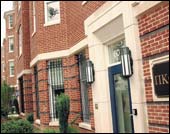 |
Members of eight GW greek organizations now reside in GW’s new Townhouse Row.
Photo by: Claire Duggan |
With its traditional-style facades and brick and stone construction, Townhouse Row, eight attached student housing units on 23rd Street between F and G Streets, seamlessly blends in with its historical Foggy Bottom surroundings. But the smooth, fresh paint on each unit’s front door—that signature “GW Blue”—makes the new student housing unmistakably part of the University.
And for student members of eight GW greek organizations, the townhouses, which each sleep 24-30 people, will be home.
“This is really exciting for the whole student body and for the greek community,” says Kris Hart, president of both GW’s Student Association and Phi Sigma Kappa fraternity. “It’s a beautiful addition to campus and an outstanding addition to residence hall life.”
Each townhouse has five floors with bedrooms located on the second, third, and fourth floors. The kitchen, living, and dining rooms are on the ground floor, and the basement holds the meeting/recreation, laundry, and storage rooms.
While fraternities and sororities have a long history at GW, this is the first time some of the organizations will have a place to reside on campus.
“Sororities have never had a home on campus, and now they have a place where members can congregate for social events and meetings, and build ber bonds,” says Laura Taddeucci Downs, executive director of the Student Activities Center.
But while each townhouse will be home to a fraternity or sorority—Sigma Phi Epsilon, Alpha Phi, Pi Kappa Phi, Sigma Kappa, Delta Gamma, Kappa Kappa Gamma, Phi Kappa Psi, and Alpha Delta Pi—the buildings are still part of GW residence hall life.
“They have the same guidelines of any residence hall, and they are still bound by University policies and procedures,” Taddeucci Downs says. “Which means any parties have to be registered with the University, and they will still be governed by health and safety regulations, the University Police Department, and all other guidelines of residence hall life.”
Hart says the student members of the greek community embrace the responsibilities and amenities of their new homes.
“The University has shown tremendous support to the greek community, and that means a lot to all of us,” Hart says. “I know that we will love our new homes and treat them with the same respect the University has shown us.”
Director of Architecture, Engineering, and Construction Michelle Honey, who helped to administer the design of the project, says her team had the students in mind during every step of the planning process.
“We wanted to create a homey environment for the students, one that would help them come together and have a shared experience,” Honey explains.
That goal was achieved, and Taddeucci Downs points out that there are already requests for more such projects from student groups.
Just across the street from Townhouse Row, construction continues on the new apartment-style residence hall, Ivory Towers. Estimated to be completed next August, the structure will and hold more than 700 beds with one-bedroom and two-bedroom units. Plans also are under way for another residence hall, to be located on F Street between 20th and 21st Streets.
Back to top | Fall 2003 Table of Contents
Trachtenberg Receives Sabin Humanitarian Award
 |
| President Stephen Joel Trachtenberg was honored by the Sabin Vaccine Institute in May. |
President Stephen Joel Trachtenberg received several awards and honors during the spring and summer months, including the Sabin Vaccine Institute Humanitarian Award. At a benefit dinner in New York May 14, Trachtenberg was recognized along with singer/songwriter Paul Simon and Montefiore Medical Center Children’s Hospital President Irwin Redlener, who are co-founders of the Children’s Health Fund.
Trachtenberg was honored for his outstanding history of public service, and was specially recognized for the Stephen Joel Trachtenberg Scholars Program, which has awarded 68 full, four-year scholarships to academically outstanding DC public high school seniors since 1989. The commitment totals more than $9 million.
“Not only are students today benefiting from his many progressive initiatives, but the city has been uplifted by his scholarship program for promising District of Columbia public school students,” says Sabin Institute Chair H. R. Shepherd. Shepherd also cites Trachtenberg’s forward-thinking vision for the University and the city, manifested in the University’s facilities in the new GW Hospital, which is home to the Sabin Institute’s human hookworm vaccine research program.
When accepting the award, Trachtenberg paid tribute to both his fellow recipients and to his GW family.
“I am humbled to be included in a group that has impacted humankind in such a positive way,” Trachtenberg says. “But, in truth, this award truly recognizes the dedication and commitment of the entire GW community—from our world-class faculty and staff to the talented students who study in our classrooms and laboratories.”
A testament to the broad range of his interests and expertise as an educational leader, Trachtenberg also was invited to serve on the board of the Chiang Industrial Charity Foundation in Hong Kong and was elected president of the Atlantic 10 Athletic Conference’s Presidents’ Council.
The Chiang Industrial Charity Foundation is a philanthropic organization that helps to fund educational opportunities for Chinese youth in business and technology and other career-related endeavors. GW and the foundation have partnered on joint programs, and the foundation has made some benefactions to the University.
Of Trachtenberg’s new leadership role in the A-10, Commissioner Linda Bruno says the decision was effortless.
“When it became time to elect a new president of the Atlantic 10 Presidents’ Council, the unanimous choice was President Trachtenberg,” she says. “His outstanding leadership and command of the many issues facing intercollegiate athletics have always been a great asset to the conference over the years.”
Bruno says Trachtenberg was just as excited to accept the honor as the A-10 was to extend it.
“President Trachtenberg has embraced the position with his usual enthusiasm and willingness to share his insight,” Bruno says. “All of us in the Atlantic 10 benefit from his tremendous knowledge.”
Back to top | Fall 2003 Table of Contents
Marvin Center Renovations Attract Visitors, Architecture Awards
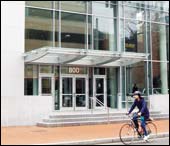 |
| The Marvin Center is home to student and visitor spaces, including the Cafritz Conference Center, Abrahms Great Hall, Dorothy Betts Marvin Theatre, and the Hippodrome.
Photo by: Claire Duggan
|
Walls of windows, spacious gathering areas, and ample meeting space characterize the Marvin Center’s latest renovations. These transformations have created an inviting atmosphere for the GW community and garnered the attention of the American Institute of Architects, two chapters of which recognized the center with two of its most prestigious awards.
The Washington Chapter of AIA awarded the Marvin Center its highest honor, Excellence in Architecture, selecting the GW submission from more than 210 entries. Praising the amount of light and life the space brought to the Marvin Center, the Virginia Society of the AIA applauded the addition for creating “both an urban building and a great social building for the students,” and presented GW with a Merit Award for Design and Excellence.
“We wanted to create a space that was state of the art and technologically advanced, but that also encouraged student interaction,” says Michelle Honey, GW’s director of architecture, engineering, and construction. “These awards, along with the positive feedback we have received from the GW community, reinforce our belief that the Marvin Center’s renovation turned out successfully.”
One part of the renovation is the new Morris & Gwendolyn Cafritz Foundation Conference Center, funded in part by a gift from the Cafritz Foundation. The center, located on the third floor of the Marvin Center, houses six individual meeting rooms, an amphitheater, two ballrooms, a lobby, and an outdoor terrace. The venue also offers fiber optic technology for audio/visual and teleconferencing capabilities as well as attractive reception areas.
Upon entering the Marvin Center on 21st Street, visitors step into the Marc C. Abrahms Great Hall—a new gathering place for members of the GW community. The addition offers a large meeting space on the first floor of the Marvin Center with a concierge desk. It also added room to the ground floor for an expansion of the GW Bookstore. The hall was made possible by the generosity of friend of the University Marc C. Abrahms, who also established the Abrahms Family Fund, which provides support for the GW Medical Center.
|
Back to top | Fall 2003 Table of Contents
GW Hosts 54th Annual Arthur S. Flemming Awards
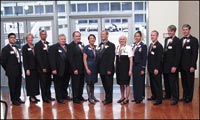 |
| The 12 Flemming Award honorees were recognized at a dinner on campus June 5.
Photo by: Abdul El -Tayef |
Joining the ranks of such honorees as the late Sen. Daniel P. Moynihan (D-N.Y.) and astronaut Neil Armb, 12 federal employees were recognized by the Arthur S. Flemming Awards Commission with Flemming Awards for 2002.
The Flemming Awards honor outstanding individuals with three to 14 years of government service and are presented to those who make extraordinary contributions to the federal government.
To celebrate his seven decades of service to the federal government and higher education, Arthur Flemming was awarded a Medal of Freedom by former President Bill Clinton in 1994. Flemming served as the president of three universities; as secretary of the U.S. Department of Health, Education, and Welfare; and as co-chair of the Save our Security Coalition.
In 1996, the awards found a new home at GW, after previously being sponsored by the Downtown Jaycees in Washington.
“Coming to GW was, in my opinion, the best possible thing that could have happened to the program,” says Peter Williams, president of the Arthur S. Flemming Awards Commission.
Kathy Newcomer, director of GW’s School of Public Policy and Public Administration, says the move was an honor for the University.
“We were thrilled to become the home for the Arthur Flemming Awards six years ago because of GW’s long history of preparing graduate students for public service careers, and our heavy involvement in community and public service,” she says. “The School of Public Policy and Public Administration is proud of our association with the most prestigious awards program for the federal government.”
Presented by GW and sponsored by Bearing Point, Inc., and SAIC, the winners were recognized at a ceremony June 5 on campus.
And The Winners Are...
ADMINISTRATIVE CATEGORY: Dan Wayne Christenson, United States Air Force; Capt. Nicholl R. Dudley, United States Air Force; William M. Moon, Defense Threat Reduction Agency of the Department of Defense; and James R. White, United States General Accounting Office.
APPLIED SCIENCE CATEGORY: Ann Azevedo, Aircraft Certification Office of the Engine and Propeller Directorate of the Federal Aviation Administration; Zalmai Azmi, Executive Office for United States Attorneys of the Department of Justice; Marc Desrosiers, National Institute of Standards and Technology of the Department of Commerce; and Katherine I. O’Rourke, Agricultural Research Service of the Department of Agriculture.
SCIENCE CATEGORY: Muhammad Arif, National Institute of Standards and Technology of the Department of Commerce; Sonja A. Rasmussen, Centers for Disease Control and Prevention of the Department of Health and Human Services; Mark D. Stiles, National Institute of Standards and Technologies of the Department of Commerce; and Peter E. A. Teal, Agricultural Research Service of the Department of Agriculture.
Back to top | Fall 2003 Table of Contents
Hatchet Celebrates 100 Years of Campus Coverage
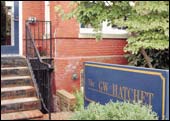 |
The Hatchet will run special editions and events to commemorate 100 years.
Photo by: Claire Duggan |
From war protests to sports victories to D.C. politics, The GW Hatchet has covered campus, Washington, and world events for 100 years. Staff and alumni this academic year will celebrate the centennial with special editions, workshops, exhibits, and open houses, culminating in a gala weekend with a dinner in March.
“The Hatchet is part of GW’s history, and also part of GW’s growth and transitions,” says General Manager Steven Morse, MPA ’93. “We have activities planned throughout the year showing where we are and where we’ve come from.”
While conducting centennial research and planning sessions, Editor in Chief Mosheh Oinounou spoke to and learned from alumni. He says the conversations captivated his interest and showed the impact he and his staff have on campus.
“I’ve talked with alumni who described their challenges as student journalists and their favorite memories—writing about protests, Watergate, the attempt on Reagan’s life, the ’60s, the ’70s, and it just amazes me,” Oinounou says. “But then we realize that we’re covering history, too. I’ll always remember riding my bike to the Pentagon with a photographer during Sept. 11, the student government elections that sometimes mirror our national government, and everything that happens in Washington.”
To kick off the festivities, the paper, which became independent of the University in 1993, changed its masthead and will publish special commemorative sections every few weeks. A centennial exhibit and reception, “From the Pages of The GW Hatchet: 100 Years of Student Journalists Covering Their World,” begins Oct. 18 and will be shown in the lobby of the Media and Public Affairs Building through May.
Claire Duggan, BA ’98, a Hatchet alumna, worked with Gelman Library staff and University Archives Librarian G. David Anderson to showcase historical items including the first edition of the Hatchet, memorable past issues, and old photographs of the newsroom.
“It’s interesting to see how, even though the times and technology have changed, the students, in some ways, have remained the same,” Duggan says. “When I was on staff, we used to joke about the late nights and long hours. When I put this display together, I came across a quote from a staff member in the ’50s in an old edition of the Cherry Tree. It read, ‘Why do we always put things off until 2 a.m.?’ Some things never change.”
Becky Sher, BA ’99, who helps to coordinate the events, says she also found a common theme when speaking with alumni and researching the paper’s past: the bonds between staff members.
“So many people said that they made lifelong friends—and in some cases, like mine, found their future husband or wife—at the Hatchet,” Sher says. “And everyone says they learned so much and gained practical and career experience there.”
Oinounou says this hands-on experience is one from which staff members will continue to benefit.
“You make your own mistakes here, and you learn a lot,” Oinounou says. “I look forward to speaking with the alumni who visit and learning from their stories as well.”
For more information about the Hatchet’s centennial events and activities, please visit the alumni Web site, www.gwhatchet.com/alumni, or contact General Manager Steven Morse at alumni@gwhatchet.com or (202) 994-1310.
Back to top | Fall 2003 Table of Contents
History in Motion
 |
(Right) GW alumnus and Associate Professor of Theatre and Dance Dana Tai Soon Burgess, MFA ’93, celebrates his heritage with Tracings, to be performed at the John F. Kennedy Center for the Performing Arts in November.Mary Noble Ours
Photo by: Mary Noble Ours
|
They didn’t want to leave, hoping their country would soon be independent again. But now it was overtaken by Japan. One hundred and twelve Korean refugees boarded the merchant ship Gaelic, arriving in Honolulu January 13, 1903—the first Korean immigrants to what would become part of the United States.
They would never go back. Within two years, Japan had extended control, blocking any further emigration from Korea; it wouldn’t be until the 1960s when any sizeable number of Koreans would move to the United States.
But in 2003, the descendants of the “First Wave”—and about a million other Korean-American immigrants—celebrate the centennial of that long winter’s voyage down the East China Sea, through the Northern Marianas, and halfway across the Pacific.
Adding to the celebration is GW alumnus and Associate Professor of Theatre and Dance Dana Tai Soon Burgess, MFA ’93, whose great-grandparents were part of the 1903 exodus. Commissioned by the Smithsonian Institution and the John F. Kennedy Center for the Performing Arts to choreograph a dance, Burgess created Tracings, to be performed at the Kennedy Center’s Terrace Theater Nov. 6 and 7.
“Their names were Chai,” Burgess says of his ancestors. “On my mother’s side, they came over in 1903, also on the Gaelic, but a month later. Another part of the family came in 1904, the Kangs. In 1905, Japan made Korea a non-entity. So there was deep sadness in the famiy—and guilt. You can’t take care of gravesites or check in with grandparents; and in a Confucian-based society, this is disgraceful. But they were fascinating self-starters. They worked so hard.”
Burgess could be describing himself as he speaks of hard work. Born in Santa Fe, N.M., he attended the University of New Mexico on a dance scholarship, earned an MFA at GW in 1993, and founded his own dance company.
Described by dance critic Alan Kriegsman as a “charismatic presence in motion,” Burgess won the Pola Nirenska Award for dance. His company tours internationally and performs in about 40 American cities a year. But he calls GW home.
He celebrates his family, and his heritage, in Tracings. It’s a history of determination and diligence. “They were scholars,” he says animatedly. “My great-grandfather had worked in the palace. But they cut sugarcane. My grandfather bought land and had a business with all my family members, including my aunts and my mother. They made lunches and did laundry. Mom’s generation worked in the pineapple fields. They would come back with 50-pound bags of pineapples and then go back out.”
Burgess is half-Korean—a “hapa-haoli” in Hawaiian. His mother wanted to be an artist; her sisters saved and sent her to art school in Michigan where she met her husband, a Yale graduate with a master’s degree in oriental studies and art history.
During his visits to Korea, he’s been struck by the difference between Asian and American cultures—and how many generations separate him and other Korean Americans from the mother country. “You get your own generational concept. You lose the language to create a new one,” he says.
In creating Tracings, Burgess did his homework—the historical research about the journey Korean Americans have made, not just across the Pacific but through the decades. He’s impressed by the Jungian concept of how the subconscious distills image into archetype. So he let the research sit, jell, and eventually become what he calls “abstract contemporary phrases, a special movement language of my own.”
“Then I teach the company, moving and manipulating them, because the stage is a moving canvas,” he says.
In July, he began studio work. And he looks forward to discussing the creative process with his audiences in November—how choreography can be inspired by historical and personal journey. It can work the other way: journeys can be inspired by choreography.
And so, creating Tracings gave Burgess a journey of his own. “This gave me the opportunity to check back into my family heritage. It’s been fascinating to see how families moved through tragedy but would keep going. Keep all the children in school. And keep looking to a future generation.”
—Bob Lehrman
Back to top | Fall 2003 Table of Contents
WRGW Reflects on 75 Years as the Student Voice
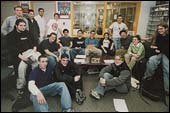 |
| The editorial board of WRGW takes a break before air time.
photo courtesy of WRGW |
For nearly 75 years, the many incarnations of WRGW have told the Colonial story through the voice of the students. From spinning records to covering campus reaction to wars, GW’s student radio devotees have kept Foggy Bottom informed and gained lifelong friendships along the way.
“While preparing for our 75th anniversary, I’ve talked to alumni of the radio station, and it’s been an incredible experience,” says graduate student and General Manager Brett Kaplan, BA ’03. “Their stories are just like ours today, just a few decades earlier.”
They are stories of late nights, working on instinct and caffeine, and gaining career skills while having the time of their lives.
“I’ve learned so much from working at the station, learning to use the equipment and bringing the campus news,” says Kaplan, who started working at WRGW his freshman year.
In 1929, student radio began when Howard Cole, Samuel Hall, and Alan Webster started the Radio Club. What began as W3ACY and survived long periods of being disbanded and changing locations officially became WRGW in 1958 and found its current home on the ground floor of the Marvin Center in 1999.
“When I talk to alumni and they tell me where they worked—in Lisner Auditorium or the fourth floor of the Marvin Center—it dates them,” Kaplan says with a laugh.
Heard on campus at 540 AM, on GW’s Campus Cable TV Channel 22, and on the Internet at www.gwradio.com, dozens of students collaborate to produce and write music, talk, and sports shows that air from 10 a.m. to 12 a.m. daily.
The work behind the scenes can be chaotic yet rewarding, Kaplan says.
“There are always a ton of people in here, sharing equipment, sharing ideas, and getting their segments together,” Kaplan explains. “I love to take a moment every now and then to just step back and watch it all come together.”
Alumni and current student employees will have a chance to swap stories and discuss career paths in February, when WRGW will kick off events to celebrate the anniversary. Kaplan and his team are planning a benefit concert, a dinner, and other events to mark the milestone.
For more information about anniversary events, please contact General Manager Brett Kaplan at (202) 994-7554, wrgw@gwu.edu, or visit www.gwradio.com.
|
Back to top | Fall 2003 Table of Contents
GW Launches First Responder Training Unit
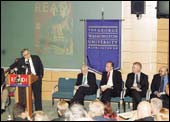 |
| President Stephen Joel Trachtenberg discusses GW’s new Response to Emergencies and Disasters Institute.
Photo by: Claire Duggan |
Washington programs are rarely launched without an acronym, accurate or not, but this is one that fits.
It is READI, GW’s Response to Emergencies and Disasters Institute, unveiled in June at the Virginia Campus in Loudoun County where the institute will be housed.
Established with the help of a $5 million federal appropriation, READI is a comprehensive system designed to train firefighters, EMTs, and law enforcement personnel—as well as public health officials and other non-traditional first responders.
“READI is the latest instance of GW’s commitment of energy and resources to help make our country a safer place to live,” said President Stephen Joel Trachtenberg at a launch ceremony that included Congressman Frank Wolf (R-Va.) and Director of the National Capital Region Coordination for Emergency Responses Mike Byrne.
Trachtenberg defined the institute’s mission as one that “brings advanced training to the individuals who need it most: first responders and those on the front lines who risk their lives to protect others.”
Creating READI is another step GW has taken to become a leader in health and security. GW Hospital has the most up-to-date decontamination unit in Washington; is home to the Level One Trauma Center that became famous after the assassination attempt on former President Ronald Reagan; and its Medical Center boasts a faculty full of experts in public health preparedness as well as bioterrorism and weapons of mass destruction.
“Congress identified a need to provide emergency preparedness and response training,” Wolf says. “READI is a fine example of this and has the potential to become a model for similar programs across the country.”
GW is the lead partner in the institute, which includes participation from George Mason University’s criminal justice and biodefense program and Shenandoah University’s pharmacy program.
Designed to provide participants with a thorough understanding of emergency preparedness, READI faculty also will develop and demonstrate “best practices” for emergency personnel nationwide. They have designed courses aimed at working professionals, with components lasting a week or less. Meanwhile, demonstrations and practice scenarios will augment class work—including mock responses to nuclear, biological, radiological, or conventional terrorist attacks.
In addition to its importance for national security, READI provides an example of something different about GW: the striking development of its Virginia Campus. Since opening the Loudoun County site in August 1991, GW has increased the student base there tenfold. The 90-acre campus offers programs in transportation safety and security, public health and medicine, information technology, and telecommunications, among others.
Loudoun County Sheriff’s Office Captain Bob Brendel, who was part of one of the first classes at the new institute, has lent his expertise to the project.
“We’re getting into nuclear and chemical and biological warfare, things I was [concerned with] in the military... not something I ever thought I’d have to deal with in Loudoun County,” Brendel says.
READI will enable officials like Brendel to be ready—whether in Loudoun County, the heart of DC, or across the nation.
—Bob Lehrman
Back to top | Fall 2003 Table of Contents
Kudos Abound for GW Faculty
GW Professor Awarded Guggenheim Fellowship
GW Elmer Louis Keyser Professor of History and International Affairs Dane Kennedy won the prestigious Guggenheim Fellowship Award for 2003.
Kennedy is among 184 artists, scholars, and scientists selected from more than 3,200 applications for awards totaling $6,750,000. Selections were based on recommendations from hundreds of expert advisers and are approved by the Guggenheim Foundation’s Board of Trustees. The honors are awarded on the basis of distinguished achievement in the past and exceptional promise for future accomplishment.
An expert on British imperial history, Kennedy will use the fellowship to complete his book Richard Burton and the Victorian World of Difference. The work is an intellectual study of Richard Francis Burton, the 19th-century British explorer, author, and translator.
“I couldn’t be more delighted,” Kennedy says. “This is an unexpected honor, and it comes at a perfect time to finish my book.”
Faculty Member Named 2003 Carnegie Scholar
Professor Sarah Binder showed that 13 doesn’t have to be an unlucky number by becoming one of 13 emerging intellectuals at American universities chosen by the Carnegie Corporation as a Carnegie Scholar for 2003.
Binder will use her grant—which could total as much as $100,000—to pursue research in the politics of federal judicial selection.
Luck, of course, didn’t have much to do with the award. “Sarah Binder’s selection as a Carnegie Scholar is an exciting and well-deserved honor that recognizes the quality of scholarship and creativity that she brings to her work,” says Don Lehman, executive vice president for academic affairs.
At a time when the fight over judicial nominations has provoked threats of filibuster and predictions of Congressional gridlock, Binder, who has been a member of GW’s faculty since 1999, seems perfectly positioned for the new project. Her previous books include Stalemate: Causes and Consequences of Legislative Gridlock (Brookings, 2003), and—as co-author Politics or Principle? Filibustering in the United States (Brookings, 1997).
Binder, who also is a senior fellow at Brookings, will examine the ways in which institutions, elections, and party politics all shape the selection and confirmation judicial nominees.
World Trade Organization Honors Professor
Lauding his “scientific contribution to the theory and practice of tourism policy,” the World Trade Organization awarded its first Ulysses Prize to a GW professor who has written or edited more than 100 works on tourism policy and strategy.
Donald E. Hawkins, Eisenhower professor of tourism policy at GW’s School of Business and Public Management, received the newly created prize from former President of Spain H.E. Leopoldo Calvo Sotelo June 3 in Madrid. Two days later he delivered the WTO Ulysses Prize Lecture to Madrid’s Chamber of Commerce.
Hawkins has researched this area since the early 1970s, facilitating active collaboration between the tourism industry and international institutions that include the WTO.
In 1974, GW became the first university to offer a master’s degree in tourism administration; U.S. News & World Report recently cited the distance format of the Master of Tourism Administration program as one of the best online programs in business.
Former Geography Chair Praised for Bettering Washington
For more than 35 years, Dorn C. McGrath was among the first to recognize trends in Washington’s metropolitan region. Recently, it was his turn to be recognized.
Washington’s Committee of 100 named the former chairman of GW’s Geography Department as one of 12 individuals and organizations who had made major contributions to the community.
In an award ceremony held in June, the committee praised the way McGrath applied his intellect and energy to improving the historical, geographical, and functional aspects of how the region looks and works.
In addition to serving as chair of the Geography Department, he was president of the American Institute of Planners from 1972-1973, and is founder and director of GW’s Institute for Urban Environmental Research.
Back to top | Fall 2003 Table of Contents
Faculty Focus
A series of personal glimpses of GW faculty members
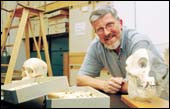 |
Photo by: Claire Duggan |
Reconstructing Human Evolutionary History
As researchers push the frontiers of science throughout the world, Bernard Wood, 2003 recipient of the Oscar and Shoshana Trachtenberg Prize for Faculty Scholarship, looks back in time for answers.
A world-renowned paleoanthropologist specializing in the reconstruction of human evolutionary history, Wood joined GW’s faculty in 1997 as the Henry R. Luce Professor of Human Origins in the Department of Anthropology. From his relic-filled office in GW’s Hortense Amsterdam House on G Street, he directs the Center for the Advanced Study of Human Paleobiology, a research facility linked to the Human Origins Program of the Smithsonian Institution.
Wood, who holds a dual appointment as adjunct senior scientist at the Smithsonian’s National Museum of Natural History, focuses on increasing understanding of human evolutionary history by improving the methods of analyzing the hominid fossil record. Much of his internationally acclaimed work is devoted to taxonomy; sorting specimens into correct species, and to phylogenetic analysis; determining relationships among those species. Wood also is interested in functional-behavioral interpretations of the fossil record, attempting to reconstruct what hominids ate, how they moved, what their social organization might have been like.
Trained as a surgeon at The University of London in his native England, Wood says a passion for anatomy ignited his interest in paleoanthropology research. While still a medical student, he joined Richard Leakey’s first expedition to what was then Lake Rudolf in 1968. “I’d never been to Africa before, and very much enjoyed looking for fossils and working with Richard Leakey,” Wood says. Leakey invited Wood to join a group of anatomists to help Leakey interpret some of his more interesting fossil discoveries. “In the United Kingdom at the time, there was much more of a tradition of human evolution research being done by anatomists who were medically qualified,” says Wood, who accepted, despite those who advised him to focus on his medical career.
An expert on the interpretation of early fossil human skulls and teeth, Wood confesses he chose his specialization in an unconventional way. “Our group was being split into three areas of concentration—and nobody wanted to focus on the head fossils,” he says. “We were meeting in a hotel in New York, and to break the impasse Richard Leakey broke matches to decide, and I picked the shortest match! So, in a sense, the direction of my research was very largely determined by the length of a match.”
Wood moved into full-time academic life in 1972, working first at The University of London and later at The University of Liverpool. At GW, he continues his career-long quest of searching for answers about the origins of humankind. “It is estimated that the last common ancestor we shared with another living animal was with the chimpanzees, most likely about six to eight million years ago,” he says. “My guess is that there are between 10,000 and 15,000 fossils representing animals that are more closely related to humans than to chimpanzees. I’m particularly interested in the animals that can be traced back to that group. What makes them distinctive? What sort of animals were they? What were there adaptations? Which of them were our direct ancestors?”
Early in his career, Wood conducted fieldwork in remote sites around the world, such as Kenya and Uganda, and he has studied fossils in China, Tanzania, Indonesia, and South Africa.
Now, electronic methods for imaging fossils have revolutionized the science, enabling Wood to examine fossil evidence from his office computer. Wood dreams of creating an international computer database packed with information on every fossil in the human fossil record. “I’m working with the National Science Foundation to try and make it a reality,” he says. If you simply typed in the key words “2.5 million years ago” and “Kenya,” for example, every fossil found in that region during that time period would pop up. Imagine an undergraduate in Dar es Salaam having access to as much information as a postgraduate in Denver.”
Wood contributes to the field that he loves, pushing the boundaries of paleoanthropology while ensuring its foundations are secure. “The nature of science is people doing their best to make sense of things with the evidence that they have,” he says. “Every time someone finds a new fossil, it’s a test of the existing hypotheses. It’s an extremely difficult science, but I ultimately love the challenge. Scientists, after all, are like conjurors. We are only as good as our last trick, so we have to make sure we keep doing high-quality tricks.”
—Jamie L. Freedman
|
New Year, New Responsibilities for GW Faculty and Administrators
As GW welcomes the 2003-04 academic year, it also welcomes new faculty and administrators. In addition, current faculty members are preparing for different roles, new responsibilities, and, in some cases, new job titles.
Coming to GW from Yale University’s School of Medicine, where she had been associate dean for administration since 1997 and assistant professor of internal medicine and epidemiology and public health, Ruth J. Katz was named dean of GW’s School of Public Health and Health Services. She also will serve as the Walter G. Ross Professor of Health Policy.
Frederic A. Siegel assumed the newly created position of associate vice president and dean of freshmen. Siegel is the principal administrator for the Mount Vernon Campus. He also oversees all aspects of the freshman experience. His duties also will include supervising Colonial Inauguration, the orientation program for incoming freshmen, as well as student life programs and general advising of the freshman class.
Siegel is no stranger at GW; he lent his dedication and expertise to the University from 1991-1997 as assistant vice president for enrollment management and director of admissions.
On July 1, Jean Folkerts Towns, former interim dean of the Columbian College of Arts and Sciences and director of the School of Media and Public Affairs, became associate vice president for special academic initiatives. In her new position, Folkerts Towns will oversee the Office of Special Academic Programs and the University Honors Program. She also will have fundraising responsibilities for the Strategic Plan for Academic Excellence.
Leaving her role as executive dean at the Mount Vernon Campus August 1, Grae Baxter became interim director of the University Honors Program. Baxter also will oversee the newly created Office of National Fellowship Competitions, which helps GW students compete in national fellowship competitions.
Rachel Heller, professor of engineering and applied science and former School of Engineering and Applied Science associate dean, was appointed to serve as an associate dean for academic affairs at the Mount Vernon Campus. Heller, who will coordinate her activities with Siegel, will report to Craig Linebaugh, whose title will change from associate vice president for academic planning and special projects to associate vice president for academic planning and development. Heller will work with each school on academic planning for the campus.
P.B. Garrett was promoted from executive director to assistant vice president for academic technology. And Cheryl Beil was promoted from director to executive director of academic planning and assessment.
James Scott will serve as interim dean of the School of Medicine and Health Sciences. Scott currently serves as associate dean of the school and now assumes all the academic and administrative responsibilites as dean, a position previously held by Provost and Vice President for Health Affairs John F. Williams since 1999.
Back to top | Fall 2003 Table of Contents
GW Gets Behind the Wheel with Zipcar
 |
| Students, faculty, and staff have access to new sets of wheels with Zipcar.
Photo by: Claire Duggan
|
From running errands across town to taking road trips to nearby Virginia and Maryland, GW and Zipcar, an on-demand car company, are making it easy for students to reap the rewards of having a car on campus without the cost of owning one.
“Students as young as 21 will be able to take advantage of the service, which is a benefit because most rental car companies have a minimum age of 25,” says Program Manager for Institutional and Auxiliary Services Gary Reynolds. “They can go to Costco and buy groceries, to Ikea and buy furniture for their dorm rooms, and do everything else they need to do.”
Zipcar also will benefit GW faculty and staff members, making it easier for those who commute to work via carpool or Metro to have a car on campus when they need one for meetings and errands.
Those wishing to rent a Zipcar go to www.zipcar.com/gwu and register with the company. After providing insurance and license information, they are issued a card key, which they may receive in the mail or pick up at a Zipcar office. Once they have a key, it is possible to reserve a car for as little as an hour, walk to a nearby parking location on campus, unlock the car with the activated card and drive. The hourly rate averages between $8.50 and $10.50, which includes parking, mileage, maintenance, insurance, and gas. Two Zipcars have been available throughout the summer with one more to be added in the fall.
“Since I only need a car a few hours a month, it’s much cheaper than owning one,” says senior Brian Kirrane. “That’s important, given my financial status.”
Zipcar’s Vice President of Marketing Nancy Rosenzweig says the program has been successful in Boston, the company’s home base, and in New York, and anticipates the program will likewise thrive at GW.
“Zipcar is a service designed for an urban setting that complements college life,” Rosenzweig says. “It’s very convenient because you rent by the hour, and that makes it perfect for students who want to run a few errands or go on a date.”
At a demonstration in downtown Washington in July, Zipcar staffers were on hand to answer questions about the car service as well as to get public feedback about a project possibly in the works, renting out Segway Human Transporters. Segways are self-balancing, electric-powered, single-person transportation devices.
Back to top | Fall 2003 Table of Contents
Renowned Journalist to Lead Minority Outreach Programs for University
She came to The Washington Post in 1961, just seven years after GW integrated its student body, and at a time when women only could wear dresses or skirts to class. During a period of 40 years, this pioneering journalist not only saw changes in education—she wrote about them, particularly in her popular column.
Now Dorothy Butler Gilliam becomes an educator herself.
The first full-time African American woman reporter hired by the Post, and a past president of the National Association of Black Journalists, Gilliam joins GW’s School of Media and Public Affairs as its J.B. and Maurice C. Shapiro Fellow for 2003-04.
“Dorothy is an accomplished and respected journalist. Even better, she possesses the vision for cultivating the next generation of minority journalists,” says School of Media and Public Affairs Acting Director Albert L. May.
The need for minority journalists inspires Gilliam, who at the Post racked up a host of firsts among African American journalists and now directs the Young Journalists Development Program. Of concern to her are not only the lack of minority journalists on the high school level, but the quality of secondary education journalism opportunities overall. “High school news is in danger all over America—40 percent have no newspapers at all, or woefully inadequate ones,” she says.
At GW, Gilliam will lecture and help the school develop a program of minority outreach, as well as shape a summer institute for training high school journalism advisers.
With degrees from Lincoln University and the Columbia University School of Journalism, Gilliam is the author of a 1976 biography of political activist, athlete, author, and entertainer Paul Robeson. She has been a fellow at Harvard’s Kennedy School, and was inducted into the National Association of Black Journalists Hall of Fame in 1992.
—Bob Lehrman
Back to top | Fall 2003 Table of Contents
At A Glance
Think Tank Honors Three Undergraduates
Three GW students have been accepted as 2003-04 undergraduate fellows by the Foundation for the Defense of Democracies. Tyler Rounding, Adam Conner, and Jeffrey Azarva won the fellowships from among hundreds of applicants to the FDD, a non-partisan Washington-based think tank that seeks to educate Americans about the terrorist threat to democracies around the world.
Beginning with a trip to Tel Aviv, Israel, in August, the fellowship will involve lectures and field trips. In January, FDD fellows will meet in Washington to further explore the historical, cultural, philosophical, and ideological factors driving terrorism, think tank officials said.
Pickering Foreign Affairs Fellowship Awarded to GW Sophomore
Heera Kamboj, a GW sophomore, won the Thomas R. Pickering Foreign Affairs Fellowship, which provides support for tuition, room, board, and fees during the junior and senior years of college. The prestigious award also offers reimbursement for books and travel for the first year of graduate study. The recipient must commit to pursuing a graduate degree in international studies from an approved university.
Participating graduate schools provide financial support in the second year of study based on need. Fellows meet annually in Washington for program orientation.
Lobbying the European Union
GW embarked on its first collaboration with the College of Europe, offering two summer courses covering politics, policies, and lobbying of the European Union. In conjunction with taking the summer course, 15 GW students from the Graduate School of Political Management traveled to the College of Europe in Brugge, Belgium, to continue their studies.
While in Europe, the students participated in an intensive two-week program in which they studied the EU and how it is lobbied by different organizations. Students took classes taught by CE faculty. The program is coordinated by GW’s Graduate School of Political Management professors Rita Roosevelt and Nick Laird, who believe it is important for their students to understand the EU from an inside perspective and to learn how to “successfully navigate the European system.” The students were given the chance to meet members of European Parliament and visit the U.S. Mission to the EU, the European Round Table, and the European Committee of the American Chamber of Commerce. They participated in workshops with key players from the European lobbying and business spheres.
Laird says the program offers a unique experience to students. “The joint courses being offered this summer provide an extraordinary opportunity that may not be available through any other forum to learn how the EU really works and how to effectively lobby the EU,” Laird says.
GW Receives Grant for Automotive Safety Research Laboratory
GW received a $410,000 grant from Hyundai Motor Company and Kia Motor Company to establish the Hyundai-Kia Automotive Safety Research Laboratory at the Virginia Campus. This award is the first installment of a multi-year grant provided to the Federal Highway Administration/National Highway Traffic Safety Administration on the Virginia Campus.
The Hyundai-Kia ASRL plans to conduct research in automotive safety in order to advance crashworthiness and to improve biomechanics engineering for the benefit of the entire safety community. The ASRL also will become the focal point of Hyundai-Kia’s safety research in the United States. In addition to funding the ASRL, the Hyundai Scholarship fund will support three GW doctoral students who will participate in the research.
2003 Graduate Wins Jack Kent Cooke Foundation Graduate Scholarship
When she was 17, doctors corrected her scoliosis by permanently attaching titanium springs and rods to her vertebrae. They gave her treatment for a problem—and a dream for the future.
“After becoming partially artificial myself, I have a different way of looking at artificial life,” says Alison Alvarez, BA ’03, who intends to build a computer system capable of “robust” interaction with humans—and has won a Jack Kent Cooke Foundation Graduate Scholarship to help her do it.
Alvarez is one of only 43 people from across the nation to win the award, one of the most generous individual scholarships in the nation. Winners receive up to $300,000 over six years.
Back to top | Fall 2003 Table of Contents
GW in History
25 Years Ago
Norma Maine Loeser, former managing director of the Civil Aeronautics Board, was appointed dean of GW’s School of Government and Business Administration—the first woman to head a major business school in the United States. According to the Hatchet, one of Loeser’s major goals at the time of her appointment was to bring an accredited master’s program to the school.
50 Years Ago
“The University is about to add another President and General to its claim to fame,” declared a May 1953 article in the Hatchet. “General Ulysses S. Grant III disclosed last week that the new library section will, by the end of the summer, be the home of a Grant Museum. Invaluable keepsakes and mementos of the famous Civil War general and president of the United States will be given to the University by the present General Grant—grandson of the president and a trustee of the school.”
100 Years Ago
According to the 1903 University Bulletin, tuition for students enrolled in more than 12 credit hours per week was $100 per annum. Those taking 12 credits per week or less were charged $7.50 per credit hour.
GW Magazine gratefully acknowledges the assistance of University Archives in the identification of interesting historical information. Readers wanting to learn more about GW’s history can find the University Archives Web site by accessing www.gwu.edu/gelman/archives. The site’s Historical Almanac is especially informative.
Back to top | Fall 2003 Table of Contents
|